California
| |
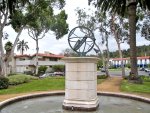 |
Palos Verdes Estates |
California |
USA |
Armillary Sphere |
Dial 740 |
| A 1.5 meter diameter bronze armillary sphere atop a beige stone pedestal at the center of a 9 meter diameter pond or fountain. The Armillary includes meridian, equatorial and horizon rings as well as Arctic and Antarctic circles. The equatorial ring is perforated with Roman hour numerals and Zodiacal symbols. The central gnomon rod has a ball at the north end and an arrow tail at the south end. |
| |
| |
 |
Paramus |
New Jersey |
USA |
Horizontal Dial |
Dial 331 |
| A ground level horizontal dial constructed from a rim of ten interlocking concrete pieces each 33 inches long. The interior is filled with an irregular concrete pieces whose edges form the hour and half-hour lines. The gnomon is iron, 51 inches from base to tip of style. The gnomon interior has a bronze statuette in the shape of a griffin taken from George Washington's coat of arms. The dial was stolen and replaced in early 1980's. |
| |
| |
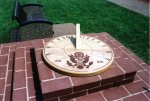 |
Park City |
Kentucky |
USA |
Horizontal Dial |
Dial 314 |
| A beautiful horizontal dial 25 inches in diameter with a 9 inch gnomon. Has hour and half hour lines from 5 am to 7pm with 10 minute marks. South of the gnomon is an intricately engraved Great Seal of The United States of America. The dial is of Coconino sandstone and sits on a brick surround. |
| |
| |
 |
Parma |
Ohio |
USA |
Armillary Sphere |
Dial 580 |
| A three foot armillary sundial with equatorial ring and gnomon pointer on a stone base with dedication plaque. Dial was built by the local high school vocational welding class in 1988. |
| |
| |
 |
Pasadena |
California |
USA |
Analemmatic Dial |
Dial 643 |
| A 14x8 foot analemmatic dial with an 8x2 foot gnomon-positioning calendar plinth. The dial is installed in the pebble and concrete patio of the Winnett Student Center. The hour markers and calendar line plinth are made of Granodiorite of Knowles, a muscovite-bearing biotite granodiorite rock quarried from Knowles Quarry at Raymond, California. A nearby wall plaque provides longitude and EOT correction. The dial is a gift from the Caltech Alumni Association as a sculpture, a public artwork and a scientific instrument. This dial is located on the private university campus but the public may walk on the campus grounds to view the dial. |
| |
| |
 |
Pearl City, Oahu |
Hawaii |
USA |
Horizontal Dial |
Dial 535 |
| A 28 foot stone horizontal dial with 8 foot high black wood and fiberglass gnomon located in a children's Sundial Garden. Hour markers are Roman numerals cast into concrete blocks. Dial is screened by koa and lonomea trees. |
| |
| |
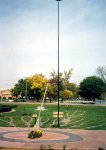 |
Pekin |
Illinois |
USA |
Horizontal Dial |
Dial 233 |
| Two sundials. One is a horizontal sundial 6-ft. tall with a sloping 15-ft bright aluminum gnomon. The dial is called "Sundance". Adjacent is a gnomonic sundial with a 45-ft pole projecting its shadow onto the lawn in front of it. The ground level dial face consists of seven analemmas drawn in the grass field that surrounds the dial center. The analemmas are drawn for the hours 8 am to 3 pm. However, the noon analemma is larger and corresponds to the shadow of a disk atop the vertical pole. |
| |
| |
 |
Pelham Manor |
New York |
US |
Vertical Dial |
Dial 901 |
| This south facing vertical dial is 4x2 feet made of concrete, now slightly brown with age. The graceful gnomon is white-painted metal. Hour numbers in Roman numerals extend from 6am to 6pm without further delineation. |
| |
| |
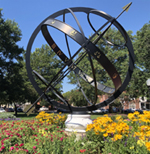 |
Pella |
Iowa |
USA |
Armillary Sphere |
Dial 1098 |
| An elegant armillary sphere approximately 8 ft (2.5m) tall. Painted black with gold Roman numerals for the hour marks. On the outside of the equatorial ring at each hour are embossed zodiac figures The gnomon is a traditional arrow with gold tip and feather. The dial has traditional arctic and antarctic rings. |
| |
| |
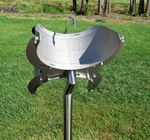 |
Pennington |
New Jersey |
USA |
Cylindrical Dial |
Dial 803 |
| This is an adaptation of the dual cylindrical sundial design by Hoffmann Albin of Butgenback, Belgium that provides for two separate dials to be displayed. In this variation, the two dials are separately displayed after being rotated and locked into viewing position every six months on the solstices. Except for two bronze sleeve bearings, all parts are 304 stainless steel that has been glass bead blasted to reduce reflection, machined, welded or laser cut. The analemmal hour lines, equinox and month lines are laser etched into the stainless steel dial plates. The dials and their supporting cradles are 12 gauge with 12" diameters. The post is 1.75" in diameter. |
| |
| |
 |
Penticton |
British Columbia |
Canada |
Analemmatic Dial |
Dial 240 |
| This analemmatic dial, the "Skaha Solar Timepiece", dates from 1984 and spans an area of 65' x 35'. At the center is a platform marked out with a steel analemma, acting as the date scale. The steel is embossed with a date scale and zodiac. The hour and cardinal direction markers are concrete posts, installed in 1998 to replace the rotted originals. The size and positioning of the analemma is somewhat mismatched to the placement of concrete markers, but overall it is a well-made piece in a pleasant setting. A nearby explanatory plaque claims, incorrectly, that this is the third-ever analemmatic sundial in the world. |
| |
| |
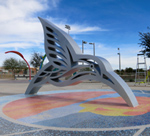 |
Peoria |
Arizona |
USA |
Horizontal Dial |
Dial 939 |
| This wonderful sculpture of a hummingbird serves as the gnomon for an 18 foot diameter horizontal sundial. The sundial sculpture was inspired by the beauty of the hummingbird with many species of them living and thriving in Arizona. The gnomon stands 7-feet tall with intricate aluminum frets welded together to give both depth and warmth to the hummingbird. Surrounding the gnomon are 150,000 Vetriluxe one-inch square glass mosaic tiles in bright colors depicting a flower where the bird sucks nectar. Inlaid into the tile work are Arabic hour numbers from 6am to 6pm as well as the cardinal points. |
| |
| |
 |
Peoria |
Illinois |
USA |
Horizontal Dial |
Dial 607 |
| An 18 inch octagonal horizontal dial of cast bronze. The dial face includes hour lines with ten minute marks and Roman numerals. The dial is on an octagonal polished granite pedestal. The bronze gnomon is correctly set at 40? but appears to be more modern than the cast dial face. This is one of two "sister" dials ordered cast by Grant Hood; the second dial was placed at Bradley School of Horology but later disposed and now in private ownership in Lynchburg, Virginia. |
| |
| |
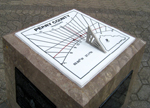 |
Perryville |
Missouri |
USA |
Horizontal Dial |
Dial 882 |
| The square 14.5-inch dial is made of while milk stone with graphics highlighted using lithochrome paint. The gnomon is made of stainless steel 303-alloy and has the letter P held between the base and style. The dial sits upon a square frustrum pedestal 3-feet tall, 24-inches square at the base, tapering to 17.5-inches at the top. The pedestal is supported on a 32-inch square base. |
| |
| |
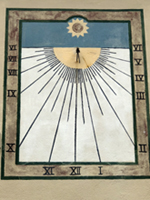 |
Perryville |
Missouri |
USA |
Vertical Dial |
Dial 916 |
| The sundial is attributed to Vincentian Brother Angelo Oliva, being painted sometime in the 14 year period between 1823, when he arrived in Perryville to lead the reconstruction of the original, wooden church into the present one made of stone, and 1837 when he died. The dial has been recently repainted. |
| |
| |
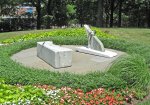 |
Philadelphia |
Pennsylvania |
USA |
Equatorial Dial |
Dial 741 |
| An equatorial projection dial with a 12 inch diameter stainless steel equatorial ring incised with Arabic hour numerals that project onto a grooved central support shaft of Cipollino and Carrara marble set on a bluestone foundation.
A hole near the top of the central marble shaft emits flowing water that runs down the central groove and is recirculated in the warm months. The sundial/fountain marble shaft is 7 inches wide, 36 inches high with a 24 by 55 inch wide base. The dial and nearby Cipollino marble bench rest on a 13-1/2 foot diameter foundation of bluestone pavers set on concrete.
Direct sunlight on the dial is limited by two of the three nearby buildings. In summer with a high elevation sun, sunlight casts gnomon shadows mid-day and for a few hours in the afternoon.
The sundial/fountain sculpture was commissioned by Society Hill Towers in honor of I. M. Pei, Architect of the Towers and was dedicated on the 40th anniversary of the Towers in 2003. |
| |
| |
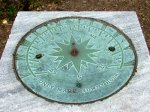 |
Philadelphia |
Pennsylvania |
USA |
Horizontal Dial |
Dial 146 |
| A 10 inch diameter horizontal dial on a 40 inch tall square marble pedestal with dedication plaque. Gnomon is missing. |
| |
| |
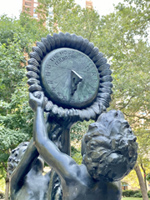 |
Philadelphia |
Pennsylvania |
USA |
Vertical Dial |
Dial 147 |
| Evelyn Taylor Price Memorial Sundial A vertical dial within a bronze sunflower held overhead in the outstretched arms of the bronze sculpture of two children. Dial is a vertical south decliner with hour marks from 6am to 6pm in Roman numerals. |
| |
| |
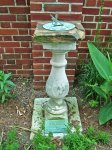 |
Philadelphia |
Pennsylvania |
USA |
Horizontal Dial |
Dial 148 |
| Horizontal dial approximately one foot diameter mounted on old stone atop a 3 foot stone pedestal. It is sitting against north wall of the garden and not aligned in proper direction. Plaque at the base states "This sundial stood for over a century in the gardens of Dorchester House, Park Lane, London, England. Presented by The Soroptomist Club of Philadelphia, December 23, 1935". This may be true for the dial plate because the hour angles indicate a latitude of 51°, the London latitude. It may not be true for the gnomon, whose style angle is 40°, the Philadelphia latitude. Access by taking guided tour, $5; then ask for garden. |
| |
| |
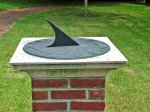 |
Philadelphia |
Pennsylvania |
USA |
Horizontal Dial |
Dial 150 |
| A 21 inch diameter horizontal dial on three foot brick pedestal. Hour lines only. Gnomon reclined. Made in 1989 to commemorate Bicentennial of the General Assembly Presbyterian Church (USA). Visible through locked gates. |
| |
| |
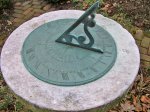 |
Philadelphia |
Pennsylvania |
USA |
Horizontal Dial |
Dial 156 |
| A 1 foot diameter bronze horizontal dial in backyard garden. May be from 18th century. The gnomon is shaky for its bolts are loose. Style angle is about 51deg, an angle for London, not for Philadelphia. |
| |
| |
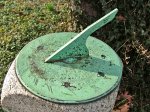 |
Philadelphia |
Pennsylvania |
USA |
Horizontal Dial |
Dial 157 |
| A 1 foot diameter bronze horizontal dial on a square granite pedestal 3 feet tall. Possibly made in 18th century. Beautiful engraving. |
| |
| |
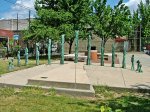 |
Philadelphia |
Pennsylvania |
USA |
Analemmatic Dial |
Dial 158 |
| Analemmatic dial with bronze standing figures. |
| |
| |
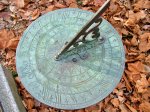 |
Philadelphia |
Pennsylvania |
USA |
Horizontal Dial |
Dial 160 |
| A 1 foot diameter bronze horizontal dial. It was presented by National Association of Watch and Clock Collectors in 1991. However, the style angle is 52deg |
| |
| |
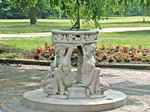 |
Philadelphia |
Pennsylvania |
USA |
Horizontal Dial |
Dial 229 |
| Bronze horizontal dial by Alexander Stirling Calder. Local Hour lines plus EoT monthly corrections and differences between 12 world cities. Tip of gnomon appears damaged. The elegant pedestal sculpture is made of white marble and depicts 4 seated young women as the four seasons holding the dial plinth on their shoulders. The plinth itself is intricately carved with the animals of the zodiac. Height 42-inches, Diameter 50-inches. The dial was a gift of Mrs. Charles P. Turner, through the Fairmount Park Art Association (now the Association for Public Art) to the City of Philadelphia |
| |
| |
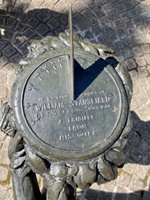 |
Philadelphia |
Pennsylvania |
USA |
Horizontal Dial |
Dial 1016 |
| In a small plaza is a beautiful bronze statue of Pan with Flute. The statue is 36 x 20 x 18 inches. His shoulder is bent to hold a 12-inch bronze sundial. Along the edge of the dial are Roman hour marks from 5am to 7pm. "In 1938, Mrs. William Stansfield presented the bronze statue, “Pan with Sundial,” to the University in memory of her husband, an alum from the class of 1902. The work is by Philadelphia native Beatrice Fenton, a figurative sculptor and portraitist who studied at the School of the Philadelphia Museum of Art and the Pennsylvania Academy of the Fine Arts. Fenton exhibited her work as the 11th member of the “Philadelphia Ten”—a group of women artists—as well as at the Art Institute of Chicago, the 1939 New York City World’s Fair and, in 1976, the Philadelphia Museum of Art. From 1942 to 1953, Fenton taught sculpture at the Moore Institute of Art. |
| |
| |
 |
Philadelphia |
Pennsylvania |
USA |
Noon Mark or Meridian Dial |
Dial 1017 |
| This meridian dial titled "The Point Where Things Change" was commissioned by the Redevelopment Authority of the City of Philadelphia. It is a large 8-foot (2.4m) diameter hoop aligned north-south. The gray painted hoop is supported at its base, covered by a narrow steel sheet cone also painted gray. The meridian dial and cone are slightly raised above a concrete pad. During the morning the shadow climbs up the AM side of the cone, at noon it rests directly on the point, and in the afternoon it starts to descend down the PM side of the cone. The Redevelopment Authority budgeted $18,000 for the meridian dial as a public art project. |
| |
| |
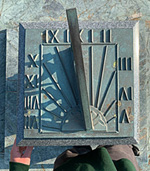 |
Philadelphia |
Pennsylvania |
USA |
Horizontal Dial |
Dial 1047 |
| In the middle of the Girard green in a large central plaza is an impressive stone dais with a square pillar rising several feet. On top is a 12-inch square dial with a smooth green patina. The dial has a wide gnomon offset to point to true north. The most striking thing is the Roman numerals that seem "upside down" from most horizontal dials. The reason is that most observers approach the dial from the north, making the dial easier to read. |
| |
| |
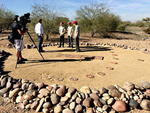 |
Phoenix |
Arizona |
USA |
Analemmatic Dial |
Dial 940 |
| On a trail of desert scrub is a cleared circular area, defined by a low pile of river stones as the border. Within is a titled analemmatic sundial about 30 feet across. The center walkway is made of sized adobe-red concrete tiles for each month. The abbreviation of each month is set into the tile. The matching hours on their elliptical arc are marked with small adobe-red concrete circles. |
| |
| |
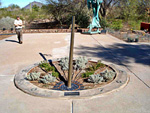 |
Phoenix |
Arizona |
USA |
Horizontal Dial |
Dial 578 |
| A 10 foot diameter horizontal dial with steel gnomon. Live desert plants fill planters delineated by hour lines. |
| |
| |
 |
Phoenix |
Arizona |
USA |
Vertical Dial |
Dial 772 |
| A dual-vertical cube dial with two 12 inch square dial plates declining 45? south of east and south of west. The east face shows hour lines for 6 AM to 12 PM; the west face shows hour lines for 12 PM to 6 PM. Roman numerals mark three hour lines on each face. |
| |
| |
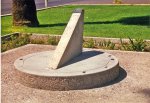 |
Phoenix |
Arizona |
USA |
Horizontal Dial |
Dial 7 |
| This large ground-level horizontal dial designed by Charles Keener. The dial is a circular concrete slab 62 in.(1.6m) in diameter and 8 in.(200cm) thick. The gnomon is 30 in. (762 cm) high, with the shadow casting style 55 in (1.4m) long. The dial has Roman numerals. Unfortunately, the 6AM and 8AM numerals are missing. The dial in a small square plaza surrounded by a row of bushes. |
| |
| |
 |
Pinawa |
Manitoba |
Canada |
Horizontal Dial |
Dial 469 |
| The Pinawa Heritage Sundial located in the center of town was constructed as a city wide effort to create pride and focus. The 17.5 foot high horizontal sundial has a gnomon constructed of steel and the 38.5 by 40.5 foot base is constructed of polished granite, rail, and granite stones. The sundial has two sets of time markers. An outer dial ring indicates local apparent time, while an inner dial ring indicates zonal solar time. Forming an integral part of the sundial, 12 icons were designed and constructed, illustrating the history of the region and its people. |
| |
| |
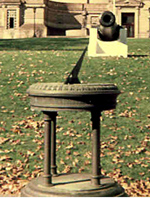 |
Pittsburgh |
Pennsylvania |
USA |
Horizontal Dial |
Dial 436 |
| Horizontal dial about 24 inches in diameter. The stone pedestal is decorated with bronze plaques and Veterans of Foreign War seals on each of the four sides. Now has an open metal base |
| |
| |
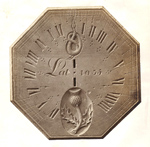 |
Pittsburgh |
Pennsylvania |
USA |
Horizontal Dial |
Dial 641 |
| A 12 inch octagonal carved sandstone horizontal dial with Roman hour numerals from 4 AM to 8 PM. The gnomon is missing. Dial face includes carved figures of a snake and a thistle and is marked latitude 40° 35'. The 1763 date ascribed to the dial's origin is coincident with the relief of the siege of Fort Pitt during Pontiac's Rebellion in that year. The 42nd and 77th Regiments of the Highland Guard and the 60th Regiment of the Royal Americans defeated the Native forces (Delaware, Shawnee, Mingo and Huron Tribes) at the Battle of Bushy Run in August, 1763, successfully quelling the Indian uprising in Southwestern Pennsylvania. The Highland Guard is artistically represented on the sundial by the thistle and the Royal Americans by the snake. Although the assignment of the 1763 date to the dial is not conclusive, the history of Fort Pitt, together with the design elements seen on the sundial and the location of its discovery, provides a plausible conclusion. |
| |
| |
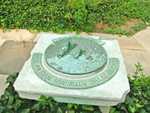 |
Pittsburgh |
Pennsylvania |
USA |
Horizontal Dial |
Dial 107 |
| In May of 1914, a beautiful sundial was erected in Schenley Park in memory of the Pittsburgh Blues, a company sent out from Pittsburgh. To remember this event Pennsylvania Chapters including the Keystone Chapter, Old Ironsides Chapter, General Robert Patterson Chapter, and the Stephen Decatur Chapter participated in the famous grave marking ceremonies which located, honored, and decorated hundreds of graves of men who served in the War of 1812 with custom made flags and flowers. |
| |
| |
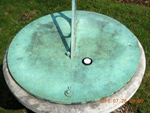 |
Pittsburgh |
Pennsylvania |
USA |
Horizontal Dial |
Dial 108 |
| A bronze and well patina circular horizontal dial about 18 inches in diameter. The dial is delineated in 10-minute increments with Arabic hour numbers. Dial sits atop a plain circular column. The gnomon is plain, secured to the dial plate with four bolts. |
| |
| |
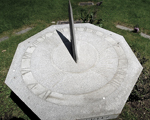 |
Pittsburgh |
Pennsylvania |
USA |
Horizontal Dial |
Dial 908 |
| This granite memorial octagonal sundial is approximately 5 feet across. The top is unadorned, containing only the delineated hour lines in 15 minute intervals and hour marks in Roman numerals from 5am-7pm. The gnomon has a sharp style |
| |
| |
 |
Pittsburgh |
Pennsylvania |
USA |
Sculpture/Artwork |
Dial 909 |
| The memorial is positioned and shaped to capture sunlight through its vertical spaces. While the sun travels the horizon, columns of light shine onto the ground, highlighting words engraved in the stone below that express individual and shared experiences about the war. |
| |
| |
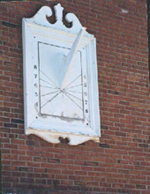 |
Pittsford |
New York |
USA |
Vertical Dial |
Dial 438 |
| This old vertical north facing dial in on the Spring House, constructed circa 1822. The building was an old Erie Canal Inn. The dial is about 48 inches high by 30 inches wide, made of wood and painted with a white boarder. The gnomon is also white painted wood and "looks upside down" because the dial faces north. The dial and gnomon have been repainted several times. |
| |
| |
|
Plymouth |
Massachusetts |
USA |
Horizontal Dial |
Dial 342 |
| approx. 8 feet in diameter Roman numerals, with half-hour marks and compass rose. Dial sits on a rectangular stone pedestal. |
| |
| |
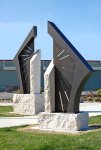 |
Pocatello |
Idaho |
USA |
Vertical Dial |
Dial 742 |
| A south-facing vertical dial split into two sculptures separated by a walking path. The dial faces are vertical powder coated steel sculptures with cut hour lines. The gnomons are travertine limestone blocks with the top edges pointing to celestial north. The edges of the gnomon stones cast the shadow onto the vertical dial faces. One dial face shows the morning hours, the other shows the afternoon hours. The gnomon styles extend to both sides of each dial face allowing extended time and season use.
This sculpture, "PASSAGE OF TIME," was commissioned by the City of Pocatello to represent Pocatello as the "Gate City," historically known as the gateway to the Snake River Plains. The meandering sidewalk path represents passage through both time and space. |
| |
| |
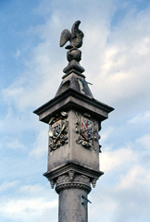 |
Pomfret |
Connecticut |
USA |
Pillar Dial |
Dial 84 |
| A 22 ft. high stone pillar dial built by William Ross Carpenter as a replica of the famous Charles Turnbull dial of Corpus Christi College in England dating from 1577. The pillar dial, called the Pelican dial, has multiple dials of various types. The Carpenter replica built in 1912 was restored in 1987. Ornate dial furniture with multiple inscriptions. A complex masterpiece. See the NASS Compendium Vol. 2 No. 1 for more details. |
| |
| |
 |
Port Arthur |
Texas |
USA |
Equatorial Dial |
Dial 446 |
| A large Erickson Monument polar equatorial dial of light colored granite, approximately 6 feet in diameter and 6 inches thick. The gnomon shaft is steel, extending from the ground through the dial plate and outward another two feet. The base is a simple tier of raised concrete. 24 hours are inscribed on each side of the dial (summer and winter) as radiating lines with Arabic numbers at the end. Time is graduated by half-hour and 5 minute marks. Two equation of time graphs, each about 3 x 6 feet engraved in granite, are set at the north and south ends of the dial, providing corrections from Apr-Sep, and Oct-Mar. [An interesting note about the engraving for the Apr-Sep graph: The line originally said "For daylight savings time, subtract one hour", the word "subtract" was filled in and "you add" was inscribed over it.] In the top quadrant of the dial (both obverse and reverse) where the sun's shadow will never cast, are the names of cities in 16 different Time Zones. A beautiful and well-crafted sundial, it makes a fitting Seaman's Memorial. |
| |
| |
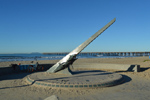 |
Port Hueneme |
California |
USA |
Horizontal Dial |
Dial 997 |
| A large, 20 ft. diameter horizontal bronze dial constructed in memory of Alaska Airlines Flight 261, which crashed 14 miles offshore nearby on January 31, 2000, with the loss of all aboard. 88 bronze plaques surround the dial on its beveled edge honoring passengers and crew who died. The dial face is simple without hour lines but Roman numerals from 8am to 4pm to mark the hours. The thin, gleaming gnomon is decorated with dolphins at the base symbolizing the sea into which the plane fell. The sundial is set in a circular plaza 36 feet in diameter. |
| |
| |
|
Port Richmond, Staten Island |
New York |
USA |
Vertical Dial |
Dial 142 |
| 17' H x 11' W x 8' D Painted steel with stainless steel wire cloth Noon mark and analemma features made of concrete and brass. |
| |
| |
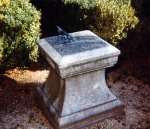 |
Portland |
Connecticut |
USA |
Horizontal Dial |
Dial 426 |
| An 18x18 inch square horizontal sundial with ornate engraving. Along the edge are Roman numerals telling the hours. The gnomon is equally ornate. Both dial plate and gnomon are made of brass. Dial sits on a tapered granite pedestal with a square granite cap. |
| |
| |
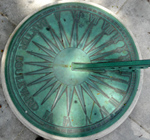 |
Portland |
Maine |
USA |
Horizontal Dial |
Dial 818 |
| A large 1m (3-foot) bronze sundial is set on a low granite dais at the center of a white granite ellipse. Surrounding the sundial are three white granite benches, the center declaring this as a memorial to Mayor James Baxter. The hour ring gives the hours from V in the morning to VII in the evening The ring is further divided into 15 minute increments. The dial has a large 24-point star and on the south end of the dial face the words "Baxter Boulevard". The artful gnomon is about 1-inch thick. Unfortunately the monument setting is heavily wooded and little sunlight reaches this fine dial. |
| |
| |
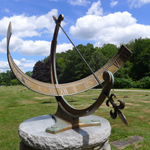 |
Portland |
Maine |
USA |
Equatorial Dial |
Dial 831 |
| Prominent in the cemetery is a large equatorial sundial about 4 ft in diameter. The dial was custom built for the location latitude and longitude. It is made of cast, anodized aluminum. The equatorial ring is 8-inch side arc with Roman numeral hours from VI to VI (6am to 6pm) with marks at 5 minute intervals. The scale is shifted to correct for longitude. The gnomon is an elegant arrow. It sits on a 4 ft plinth made of river stone, capped with a circular 6 inch block of polished granite. |
| |
| |
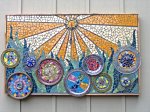 |
Portland |
Oregon |
USA |
Vertical Dial |
Dial 660 |
| A 4 x 2.5 foot south-facing vertical dial of mosaic tile whose hour lines include longitude correction. |
| |